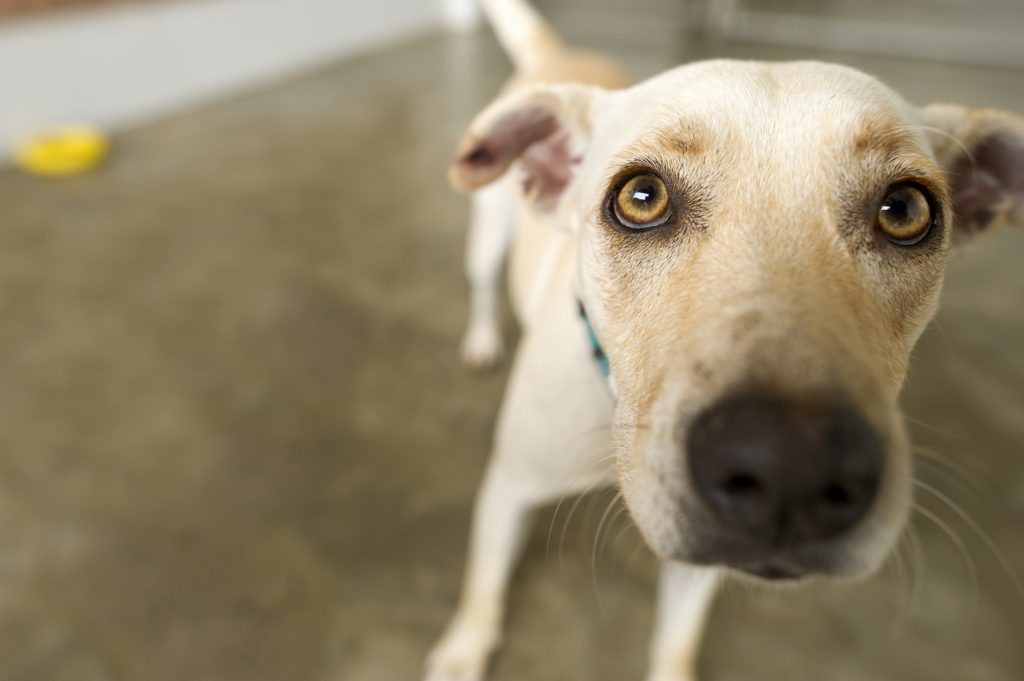Itchy, swollen, pesky, red lumps—the tell tale sign of hives. These symptoms are something that most people have experienced at one point or another, and unfortunately, dogs are susceptible to this type of reaction as well.
Urticaria, more commonly known as hives, can form as when a dog is exposed to a variety of different allergens. When the body is exposed to an allergen either through ingesting it, breathing it in, direct contact with the skin, or injection (such as a vaccine), the immune system reacts by putting the body in a hypersensitive state. This hypersensitive state results in the itchy bumps called hives.
Hives on dogs are typically not life threatening and will often go away on their own, but it is important to identify what is causing the hives so that your dog is not exposed to it time and time again. Hives can last anywhere from 24 hours to a number of weeks if left untreated, so it is essential that you get to the root of the problem so that the hives do not persist. If you are not aware of the cause, it is impossible to prevent further outbreaks.
Signs & Symptoms of Hives on Dogs
There are a variety of potential allergens that spark hives on dogs; however, the first step in getting rid of canine hives is to recognize that your dog has them. When a person has hives it is apparent because of the red, swollen lumps that appear on the skin’s surface. Because the large majority of dogs are covered from head to paw in fur, it is more difficult to tell if they are experiencing an allergic reaction.

A few ways to tell if your dog has hives is to keep an eye out for these common symptoms. The first indicator to be on the lookout for is excessive itching. When your pooch has hives, he will most likely be scratching much more than usual. Use this physical action as a sign that you should take a closer look at your pup’s skin to see if there appears to be hives.
In addition to an increase in scratching, your dog’s face may become swollen. The face is one of the primary areas that is impacted by hives on dogs. Hives can appear anywhere on the face, but the muzzle is typically the most swollen. If your pup’s muzzle appears to be a bit poutier than normal, he may have hives.
Another place where hives make an appearance on the face is near the eyes. If your dog’s eyes are red and swollen shut, he may have hives. In addition to scratching and swelling in the face, you may also see raised bumps on your dog’s body.
Depending on your dog’s build and coat, this symptom will be more difficult to identify on some dogs over others. If you notice any of these symptoms on your four-legged friend, take a closer look it see if he has hives.
What to Do If Your Dog Has Hives
Once you have determined that your dog has hives, you should take him to the vet. The veterinarian can help you get to the root of the problem. It is important to take action right away because the allergic reaction could worsen and even lead to swelling in the throat depending on the severity of the reaction.
Additionally, your dog may begin scratching so excessively that he further irritates his skin and heightens the hives. They may also scratch so much that they break skin and cause an injury or infection. Even though hives are a common allergic reaction that many people have dealt with over the course of their lives, it is important not to take the matter lightly.
How to Treat Dog Hives
The veterinarian will likely provide your pup with an antihistamine or a steroid shot depending on the intensity of the reaction. The vet may even recommend that you allow the hives to run their course and simply keep an eye on your dog if the reaction does not seem too threatening.
However, the vet will need your help with identifying what triggered the reaction to begin with. As your dog’s owner, you will be quizzed on any recent changes in diet, exposure to new places, new gardening habits and more. By thinking deeply about the potential causes, you can eliminate the allergen from your dog’s life to avoid further allergic reactions.

Causes of Hives on Dogs
Vaccines
One of the main causes of hives on dogs is an allergic reaction to a recent vaccination or medication. The reaction will typically show up within 24 hours of the vaccination, and you will need to take you furry friend back to the vet for further examination. When a vaccine is the source of the reaction, it is easy to identify because the hives appear shortly after administration and your vet will warn you to be on the lookout for any adverse reactions to the shot.
Most dogs will not experience an allergic reaction; however, some dogs will and the severity can range. If your veterinarian feels that the reaction will go away on its own within 24 hours, the recommendation will likely be to let the hives go away on their own without medication. If this is the case, you may be advised to try to keep your dog from scratching by placing a cold, moist towel on the inflamed areas.
On the other hand, if the reaction is severe, a steroid or oral antihistamine such as Benadryl may be prescribed. Although you never want your dog to experience an allergic reaction, when it is a result of a vaccination such as a rabies shot or Bordetella shot, it is easy to pinpoint what triggered the reaction and you do not need to make any further lifestyle changes.
Soaps & Shampoos
Another potential culprit that may be causing your dog to have an allergic reaction is the type of soap or shampoo you use for his baths. Dogs have very sensitive skin and should only be bathed on occasion. Excessive bathing dries out the skin, causing itchy, flaky patches as well as a dull, brittle coat. If the shampoo you use on your dog is not an all-natural, organic, unscented variety, this may be what is triggering the reaction.
Artificial fragrances, coloring, and additives may be what sparked an outbreak of hives on your pup. If you recently took your dog to the groomer, check in with them to see if they used a new type of shampoo or other grooming product. If you wash your dog at home, look at the shampoo to see if it is a different type other than what you typically use.
If the answer is yes, take a close look at the back of the shampoo bottle and examine its ingredients. The next time you purchase shampoo for your dog, try to avoid brands with similar ingredients. In general, it is always safest to use an all-natural brand of shampoo to avoid any unnecessary allergic reactions.
Food
Your pet’s food may also be at the source of this pesky allergic reaction. According to Wynn, former president of the American Holistic Veterinary Medical Association, nearly 10% of all allergic reactions amongst dogs stem from a food allergy. Every dog is different, so it is hard to pinpoint the one ingredient that may be causing your pooch to breakout in hives; however, there are a few common culprits.

Some dogs are genetically dispositioned to be allergic to certain foods including dairy, wheat, soy, egg, beef, pork, chicken, lamb, rabbit and fish. Seems like just about everything a dog typically eats, right? That is the tricky part of identifying the cause.
If you recently switched brands or types of dog food, look at the new label compared to your old brand and try to see where the differences lie. If you have not recently switched foods, but you think that a food allergy is what is sparking the hives, you can put your dog on a strict elimination diet.
This entails eliminating everything from your dog’s diet that he has had in the past to help you find what is causing the allergic reaction. Once your dog’s system is clean of all potential allergens, slowly add back foods one at a time to pinpoint the problem. For example, if you normally feed your dog kibble and a beef blend wet food, instead try serving him pure chicken and sweet potatoes.
Ideally, you want to serve your dog something that he has never or has very rarely eaten in the past. While recommendations vary from vet to vet, you should keep your dog on this diet for at least a month or until the allergies subside. After establishing that your dog is not allergic to the chicken or sweet potatoes, add one more element back into his diet such as fish.
After you have determined that he is not allergic to fish, move onto the next food item. Although this is a lengthy process that you do not want to rush through, it will help you get to the bottom of the problem so that your pup does not continue to suffer from hives. Generally speaking, big name dog food brands are often high in wheat and other non-meat products, so opt for a natural food brand with more nutrients and less processing.
Environment
Your dog’s environment may also be at the root of his allergic reaction. There are a lot of plants that your pup could be allergic to, but poisonous plants such as poison oak or ivy are at the top of the list. If you recently took your dog to an area such as a riverbed or another location where these plants thrive, you may have your answer.
In addition to the overtly poisonous plants, Allergy-Free Garden recommends avoiding Bermuda grass, Bottlebrush, Daylilies, Euphorbias, Fruitless Mulberry trees, male Juniper bushes, male Yews, and Podocarpus shrubs. However, the easiest way to pinpoint the allergen is to think about recent changes that you have made to your yard or garden.
Did you recently plant a new bush or did a tree come into bloom for the first time since you have had your dog? These changes in environment may help you identify which plant your dog is allergic to. In addition to recent changes in your landscape, think about if you took your dog to a new park or location where he was exposed to new plants. These may be what are causing those irritating hives.
Pesticides
Another garden-related factor that may be sparking your dog’s hives is a pesticide or insecticide. People often spray these harmful chemicals around the house to get rid of weeds or unwanted critters; however, it is important to think twice about how these chemicals are impacting your pets.
If a pet ingests one of these poisons, his life is at risk. Even breathing in the chemicals or inadvertently putting them in contact with your pet’s skin can result in detrimental effects. Hives are amongst the potential reactions, but more serious health issues can arise as a result of exposure to pesticides and insecticides.
When using these dangerous chemicals, make sure to carefully read the instructions and keep your pets out of the area. If possible, avoid using these materials all together. If you recently starting using one of these chemicals around your house, it is likely that this is what is causing your dog’s hives. Stop any further use of the chemical to avoid igniting your dog’s allergies.
Hives on dogs vary based on the source of the reaction and the severity of the irritation. Keep an eye out for the symptoms of hives so that you can put an end to the issue before it worsens. While hives will often go away on their own after 24 hours, if they do not, it is important to seek veterinary help in order to get rid of the irritation and ensure that the reaction does not progress.
If you choose to wait the 24 hours before seeing a vet, alleviate your dog’s hives by placing a cool, wet towel on him or giving him a cold bath. Although your dog may not be thrilled about bath-time, the cool water will soothe the hot, irritated welts. Once you see a vet, they can advise you on the next steps.
Regardless of the treatment method, it is important to identify the cause of the hives so that you can eliminate that element from your dog’s life to avoid further outbreaks.
Sources:
- “Hives in Dogs: Causes, Symptoms and Treatment Options.” PetMD, Accessed 23 Aug. 2017. www.petmd.com/dog/conditions/skin/hives-dogs-causes-symptoms-and-treatment-options.
- “Hives Due to Allergies in Dogs – Symptoms, Causes, Diagnosis, Treatment, Recovery, Management, Cost.” WagWalking, 27 Oct. 2016, Accessed 23 Aug. 2017. www.wagwalking.com/condition/hives-due-to-allergies.
- Ashton, Jenna. “Allergic Reactions in Dogs: Common Signs, When to Worry and Tips to Prevent Them.” Vetstreet, Accessed 23 Aug. 2017. www.vetstreet.com/our-pet-experts/my-dog-just-came-inside-and-her-eyelids-and-muzzle-are-swollen-whats-going-on.
- “Common Allergies That Cause Hives in Dogs.” VetInfo, Accessed 23 Aug. 2017. www.vetinfo.com/common-allergies-that-cause-hives-in-dogs.html.
- Geier, Elisabeth. “6 Signs Your Dog Is Having an Allergic Reaction.” Rover, 31 May 2018, Accessed 23 Aug. 2017. www.rover.com/blog/dogs-allergic-reaction-signs/.




